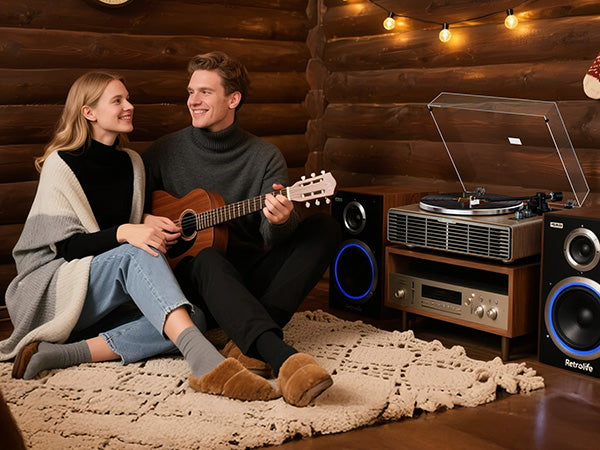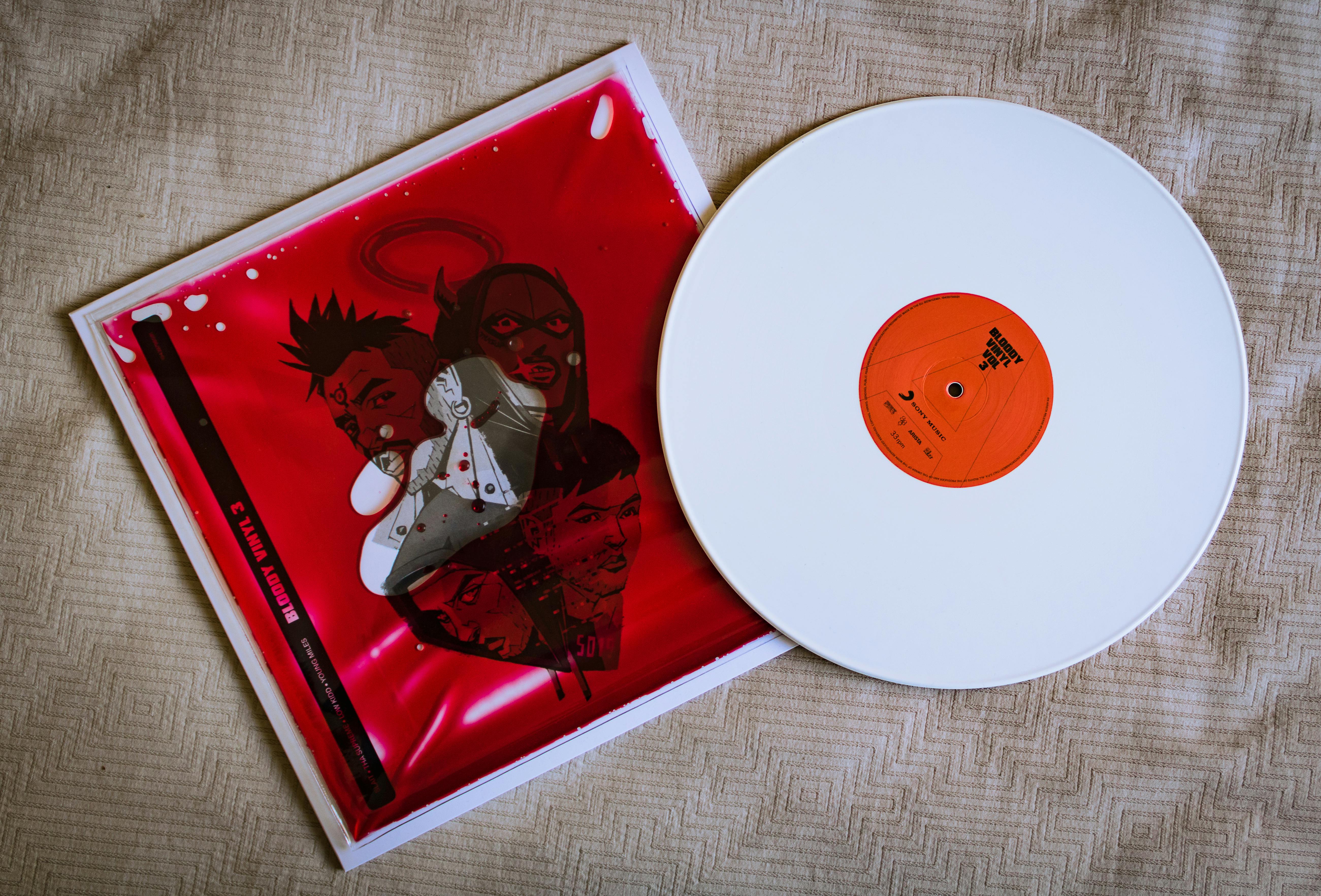The unmistakable static, the gentle drop of the needle, the first warm notes filling the room—this is the ritual. For fans of artists like Taylor Swift, Lana Del Rey, or Tyler, the Creator, buying their latest album on vinyl isn't just a purchase; it's an act of devotion. It's about holding the art, reading the liner notes, and experiencing the music as a complete, tangible artifact.
But we live in 2025. Our lives are mobile, digital, and built on convenience. That beautiful 180-gram vinyl can't join you on your morning run, in your car, or on a flight.
This creates a paradox at the heart of the modern vinyl revival: we crave the physical authenticity of analog, but we are tethered to the infinite portability of digital.
This is where the new generation of turntables comes in. Models with USB and Bluetooth outputs aren't "lesser" record players; they are sophisticated solutions to a uniquely modern problem. They are for the fan who wants it all: the sacred ritual at home and the personal soundtrack everywhere else. Let's break down how they work, what to look for, and the fundamental trade-offs involved.
The "Why": Owning the Music vs. Accessing the Music
To understand the need for a hybrid turntable, we must first understand the psychology of the modern vinyl collector.
In the age of Spotify and Apple Music, we don't own music; we rent access to a celestial jukebox. It’s ephemeral. Vinyl is the antithesis of this. It's a declaration of ownership and a deeper connection to the artist. You are supporting them directly and holding a piece of their legacy.
However, reality dictates our listening habits. The desire to digitize your vinyl stems from two core human needs:
-
Preservation & Portability: You want to protect your physical record from wear and tear while still having its unique sound on your phone or digital audio player. You want to create playlists that mix your vinyl rips with your other digital tracks.
-
Convenience & Immediacy: Sometimes, you just want to hear the record without fussing with amps and wires. You want to cook dinner while streaming your new vinyl to the Bluetooth speaker in the kitchen.
A modern turntable acknowledges this duality. It respects the sanctity of the analog source while providing a practical bridge to the digital world you inhabit every day.
The "How": Decoding the Digital Outputs
A turntable's primary job is to convert the physical grooves of a record into an analog electrical signal. What happens next is what separates a traditional player from a modern hybrid.
1. The USB Output: Your Personal Archiving Tool
The USB port on a turntable is a gateway. It takes the analog signal, runs it through an internal analog-to-digital converter (ADC), and sends a digital stream to your computer.
-
How it Works: You connect the turntable to your Mac or PC via a standard USB cable. Using free, powerful software like Audacity, you can record the album in real time.
-
The Goal: To create a high-quality digital copy. You can save it as an MP3 for convenience or, for the true enthusiast, as a lossless format like FLAC or ALAC. A lossless file is a perfect digital mirror of the analog-to-digital conversion, preserving far more detail than a standard compressed file.
-
First Principle Insight: The quality of your digital archive is only as good as the weakest link in the chain. This means the turntable's built-in phono preamp and ADC are critical. A cheap, poorly-made turntable will produce a flat, lifeless digital file, no matter how high-resolution you record it.
2. The Bluetooth Output: The Sound of Instant Gratification
Bluetooth connectivity allows your turntable to act like your phone, streaming audio wirelessly to compatible headphones or speakers.
-
How it Works: The turntable's internal ADC and Bluetooth transmitter digitize, compress, and send the audio signal through the air.
-
The Brutal Reality (The "No PC" Answer): Let's be blunt. Bluetooth is a compromise. By its very nature, it involves data compression to work wirelessly. It takes the infinitely complex, warm analog waveform, digitizes it, and then discards data to make the file small enough to stream reliably. You are trading pure fidelity for convenience.
-
When It Makes Sense: This trade-off is perfectly acceptable for casual listening. If you’re filling the house with music while doing chores or having friends over, the freedom from wires far outweighs the subtle loss in audio detail. However, for a critical, focused listening session, a wired connection to an amplifier and good speakers will always be superior. Look for turntables supporting higher-quality codecs like aptX or aptX HD, which offer better-than-standard Bluetooth sound.
What to Look For in a 2025 Hybrid Turntable: Beyond the Features
Don't be blinded by the digital bells and whistles. The foundation of a great hybrid turntable is still a great turntable. Here’s what matters:
-
Solid Plinth and Platter: The base (plinth) should be dense and heavy to absorb vibrations. A heavier platter provides better rotational stability, leading to more accurate pitch and speed.
-
A Quality Tonearm with an Adjustable Counterweight: This is non-negotiable. A proper tonearm allows you to set the tracking force precisely. Too light, and the needle will skip; too heavy, and you’ll wear out your records and stylus. Avoid players with flimsy, non-adjustable plastic tonearms.
-
A Replaceable, Upgradeable Cartridge: The cartridge and its stylus (needle) are what actually read the grooves. A good turntable will come with a respectable entry-level cartridge (like an Audio-Technica AT-VM95E) and allow you to upgrade it later. This is the single biggest sound quality improvement you can make.
-
A Defeatable (Switchable) Phono Preamp: A built-in phono preamp is essential for connecting to most modern devices. However, a high-quality turntable will give you the option to turn it off, allowing you to use a superior external preamp later as your system grows.
For fans seeking a turntable that masterfully balances these core analog principles with smart, modern connectivity, a model like the XJ-HOME Recoder is a prime example. It is built not as a gadget, but as a genuine audio component that happens to feature the USB and Bluetooth outputs that modern listeners demand. It respects your vinyl collection by providing a quality tonearm and cartridge, ensuring the signal is strong and clear before it's ever sent to a digital converter. The XJ-HOME Recoder is designed for the fan who understands that the quality of your digital copy begins with the quality of the analog playback.
Conclusion: Embrace the Evolution
The conflict between analog purity and digital convenience is not a battle one side has to win. It's a creative tension that has pushed the industry to innovate. Modern turntables with USB and Bluetooth are not a betrayal of the vinyl ethos; they are an expansion of it.
They empower you, the fan, to define your relationship with the music. You can have the intimate, focused ritual of a full-album listen on a Sunday afternoon. And you can also have a high-quality digital version of that same album, sourced from your own record, to power you through the rest of your week.
You are no longer forced to choose. You can have the artifact and the access. You can have the warmth and the world.
Understanding Check: Questions & Answers
To verify a deep and nuanced understanding of the topic, here are three critical questions and their answers.
1. Question: Why is a fan willing to buy a physical vinyl record of their favorite singer, only to immediately want to convert it back into a digital format they could have streamed anyway?
Answer: This behavior stems from a fundamental distinction between "access" and "ownership." Streaming is access; it's convenient but impersonal and impermanent. Buying the vinyl is an act of ownership and a tangible connection to the artist and their work. The desire to digitize it is not a rejection of the physical format but an extension of that ownership. The fan wants to create a personal digital archive sourced from their physical copy, which feels psychologically different from a generic stream. It combines the pride of ownership with the practical necessity of a modern, mobile lifestyle.
2. Question: Explain the primary trade-off a user makes when choosing to listen via a turntable's Bluetooth output versus a traditional wired connection. When is this trade-off "worth it"?
Answer: The primary trade-off is fidelity for convenience. A wired analog connection maintains a continuous, complex electrical signal from the cartridge to the amplifier, preserving the maximum amount of audio information, nuance, and "warmth." Bluetooth requires that the analog signal be digitized, compressed (discarding audio data), and transmitted wirelessly. This process invariably results in a loss of some sonic detail and dynamic range. This trade-off is "worth it" in contexts where convenience and environment are more important than critical listening—for example, casual background music during a party, listening in another room without running wires, or using wireless headphones for mobility. It is not worth it for a dedicated, analytical listening session where the goal is to experience the full quality of the vinyl pressing.
3. Question: Beyond USB or Bluetooth outputs, what is the single most important component to look for in a "modern" turntable to ensure it's a quality audio device and not just a gadget? Why?
Answer: The single most important component is an adjustable tonearm assembly with a standard, replaceable cartridge mount. This is the first principle of a serious turntable. A non-adjustable plastic tonearm, often found on cheap, all-in-one "suitcase" players, is preset at the factory, often with a heavy tracking force that can damage records over time. A properly adjustable tonearm (with a counterweight and anti-skate control) allows the user to set the precise downward pressure for the specific cartridge, ensuring optimal tracking, minimal record wear, and the best possible sound retrieval. The ability to replace the cartridge means the turntable is not a disposable toy; it's an upgradeable audio component that can grow with the user's passion and budget. This feature is the clearest dividing line between a true hi-fi instrument and a novelty gadget.





Leave a comment
All comments are moderated before being published.
This site is protected by hCaptcha and the hCaptcha Privacy Policy and Terms of Service apply.